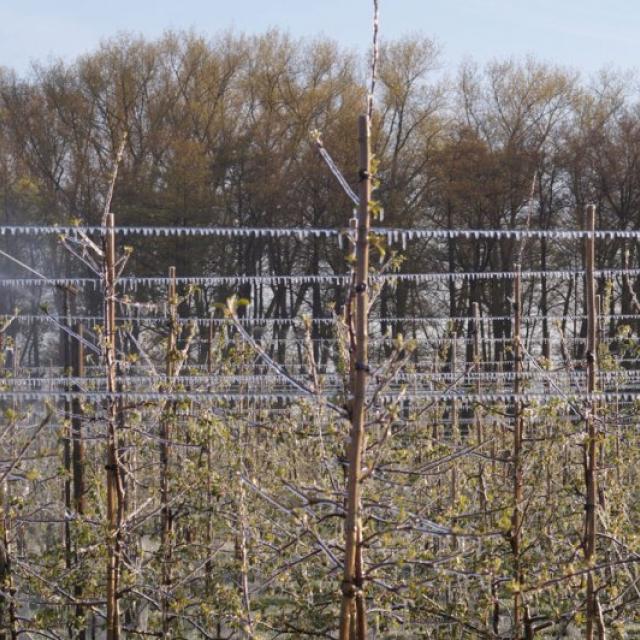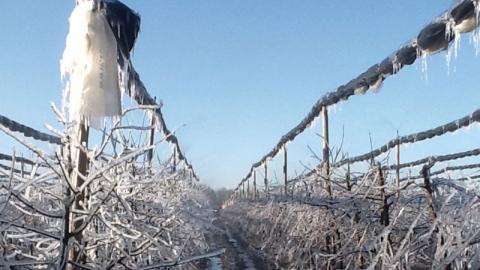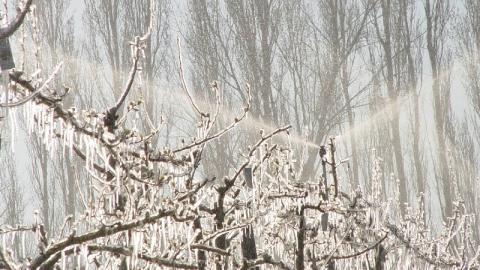The world around us is changing. Change has always been a part of this planet,
but recently the rate at which change occurs has been accelerating. Extreme weather phenomena, such as tsunamis, earthquakes and floods are becoming more and more common. Many researchers are focusing on climate change and its effects. Scientists now know how to explain these phenomena, at least in part, but we are still unable to fully predict events such as heat waves and heavy rains.
It seems as if nature itself is changing. And although we, the human race, probably have a hand in this, we find ourselves helpless against the outcome. However, despite the fact that the world is becoming a more extreme place and change of life is upon us, the basic laws of nature haven’t changed and probably never will. These essential laws of nature - physics, chemistry and thermodynamics – together with our ability to understand them and use them, provide us with the chance we need to meet this great global challenge.

The natural and agricultural environment is highly affected by climate change. The leafing out, blooming, flowering, ripening of fruits, water balance and so on are all very susceptible to stress and severe damage as a result of the extreme weather.
One of these extreme weather events is the drop of temperatures below 0c, namely frost. When these drops in temperature occur out of season, the plants are ill-equipped to cope with it on the physiological level, and they suffer severe damage as a result.
There are two kinds of frost:
• Advection Frost (Windy Frost or Black Frost) occurs when a cold air mass (cold front) moves into an area, bringing freezing temperatures. Wind speed is usually above 8 km/h. Possible protection against this kind of frost is very limited.
• Radiation Frost occurs when, with a clear sky and calm winds, the temperature near the surface of the earth drops to below freezing point. As temperatures drop, the cold air flows downward to lower topographic areas. That is where most of the damage is seen. Efforts have been made to come up with a solution for this kind of frost; a way to alleviate the damage caused by the low temperatures. In order to do so, we utilize the same basic laws of nature that play an important role in creating the frost itself.
Latent Heat
When water freezes, it actually changes phase from liquid to solid, thus sustaining a lower energy level. The excess energy is released to the immediate environment. To be precise, each gram of water that freezes releases 80 calories. Therefore, the actual process of freezing is in fact heating the surface on which it takes place. This is one of those laws of nature we have managed to utilize to our advantage.
Many methods have been used to protect fields and plantations from frost, including smokers, wind machines, helicopters, the burning of tires and the use of sprinklers. Some methods have been more successful than others.
Let’s compare the efficiency of some of these methods: Burning one liter of diesel oil in a heater releases 9,321 kcal into the air. Alternatively, it is possible to use the same single liter of diesel oil to operate a pump that will deliver water to the designated area. It is estimated that 14 cubic meters of water can be received by one liter of diesel oil. There is about 1,120,000 kcal of energy in 14,000 liters of water. The implication is 9,321 kcal compared with 1,120,000 kcal. This is 120 times better, providing the water with an advantage in energy, when compared with burning fuel.
Frost Protection by Sprinkler
We can therefore conclude that frost protection by irrigation, and by using the latent heat released during the freezing process, is the most effective approach in most cases. There are different ways to use sprinklers for frost protection, taking many factors into consideration. However, the same thermodynamic principles apply to all methods of irrigation: A minimum of 3.0 mm/h is required. This is enough to provide protection in temperatures as low as -3 °C. Another 0.5 mm/h is required for every additional degree, i.e. if the temperature is -4.0 °C, the minimum application rate will be 3.5 mm/h (35 m3/ha/hour).
Methods of Water Application
• Overhead Full Cover.
Overhead sprinkler irrigation is a very common practice in frost protection. Overhead irrigation provides excellent frost protection in temperatures of -7 °C and lower if the application rates are sufficient and the application is uniform. Drawbacks of this method are that severe damage can occur if the sprinkler system fails; the method requires extensive water consumption; ice loading can cause branch damage; and root disease can be a problem in poorly drained soils. Water logging and soil erosion may also be a problem due to the large amount of water needed for overhead full cover frost protection.
Application rate requirements for overhead sprinklers differ for conventional rotating, variable rate, or low-volume targeted sprinklers. As long as there is a liquid-ice mixture on the plants, with water dripping off the icicles, the coated parts of the plant will be protected. However, if an inadequate precipitation rate is used, or if the rotation rate of the sprinklers is too slow, all the water can freeze and the temperature of the ice-coated plants can fall to subzero temperatures.
Conventional overhead sprinkler systems use standard impact sprinklers to completely wet the plants and soil. Sprinkler distribution uniformity is important to prevent inadequate coverage, which might result in damage. In most cases, the sprinkler heads should be mounted at 30 cm or higher above the top of the plant canopy to prevent the plants from blocking the spray. For frost protection, specially designed springs are often used, which are protected by an “enclosure” to prevent the icing of the heads. In short, the conventional overhead full cover method, when applicable, provides excellent protection and is the most common and safest frost protection solution.
• Under-tree Sprinkler Irrigation. For under-tree
micro-sprinklers, which apply less water than conventional sprinklers, the goal is to maintain a temperature of about 0 °C only on the ground under the trees. This is in order to concentrate and enhance radiation and sensible heat transfer upwards into the plants. In some places there is a tendency to avoid wetting the foliage of the trees. In this case, under-tree sprinkler irrigation is adequate. However, this application can only protect the trees to a limited extent. It is customary to use under-tree frost protection only when the expected minimum temperature is higher than -2 C°. Furthermore, even at temperatures of -2 C°, when using under-tree sprinkler irrigation, there is a risk of exposing the upper parts of the tree to frost damage.
• Targeted Sprinklers.
Targeted sprinklers spray the water directly onto the plants, with smaller amounts of water falling between plant rows. Usually a single micro-sprinkler is positioned above a single tree.
A big advantage of using targeted sprinklers is that conventional sprinklers often have very high flow rates, whereas targeted sprinklers commonly have much lower flow rates. Needless to say, this saves large amounts of water and consequently mitigates the disadvantages of the conventional impact sprinklers and saves money. One of the advantages of targeted micro-sprinklers is their ability to protect larger areas with a given amount of water. On the other hand, one of the limiting factors of this kind of frost protection is the possibility of water freezing inside the narrow tubes leading up to the emitters. The flow velocity will determine the point of freezing. When planning a frost protection system using the targeted method, this should be taken into account and a sufficient flow velocity should be ensured. The same principle applies to the “Strip” method presented below.
• Strip.
The latest, most adaptive frost protection solution is strip Application. As mentioned previously, in order to provide efficient frost protection, the precipitation rate should be a minimum of 3.0 mm/h to protect at temperatures as low as -3 °C. Another 0.5 mm/h is required for every additional degree.
For example: To provide frost protection at the expected temperature of -7 °C, we would have to apply 5 mm/h of water. Using the overhead full cover method, we could reach a discharge rate of 50 mm per hectare in 1 hour. This requires a huge amount of water. The system requirements in this case are very high, and using such a high flow rate may not supply enough water to provide protection for the whole area.
We offer a new approach. In many cases, especially in apple orchards, there is a 3-meter gap between the rows of trees, and the rows themselves are very narrow, creating a “fruit wall” configuration. Other crops, such as berries, grapevines, or vines in general, are also grown in narrow rows. If we could just irrigate only the row itself, without applying water to the spaces between rows, we would be able to save huge amounts of water, making it possible to protect a much larger area at the same time. We would save money on the irrigation system requirements and we would prevent damage caused by applying 50 mm/hectare each hour for the duration of the night.
The bottom line is precision. Only the plants need to be protected; not the roads or the spaces between trees.
Going back to the example above: To provide frost protection at the expected temperature of -7 C°, we would have to apply 5 mm/h of water. As opposed to 50 mm per hectare in 1 hour, we would actually use only 16 mm per hectare in 1 hour using the strip irrigation method, while providing the same exact precipitation rate and the exact same protection.
This table shows the differences between the various frost protection methods. Clearly, it is possible to achieve the same protection, while saving substantial amounts of water and increasing efficiency.
It is clear that conditions are changing. It is also clear that new approaches and technologies are already here. It is important for us to be able to see more than one step ahead because many resources are limited.
Fresh water is a resource we all depend on. It is becoming scarce and we must learn how to use it more carefully. Adopting new and better ways to achieve our goals, which conserve our planet’s resources, is beneficial not only to ourselves, but to the environment in general.


